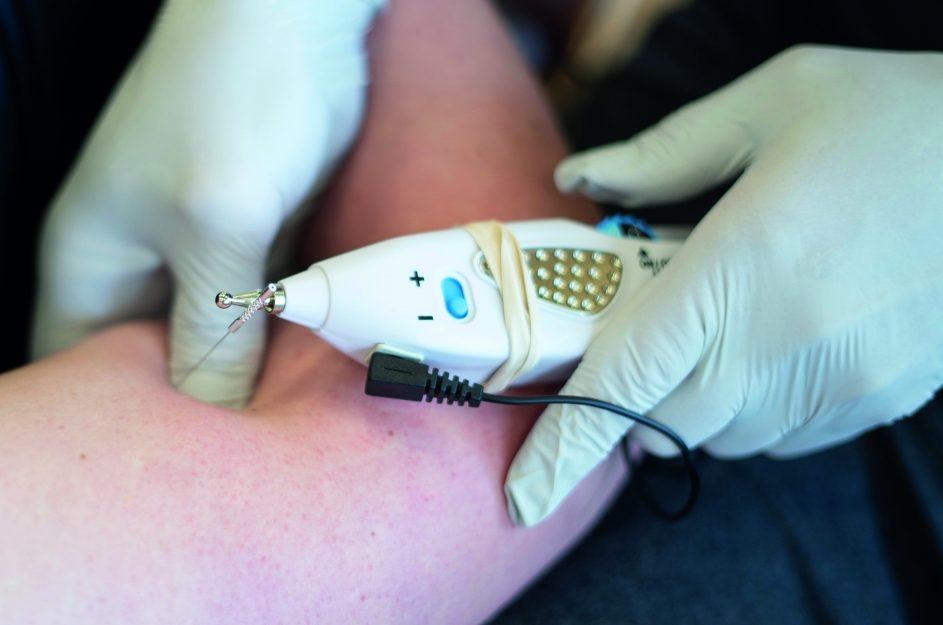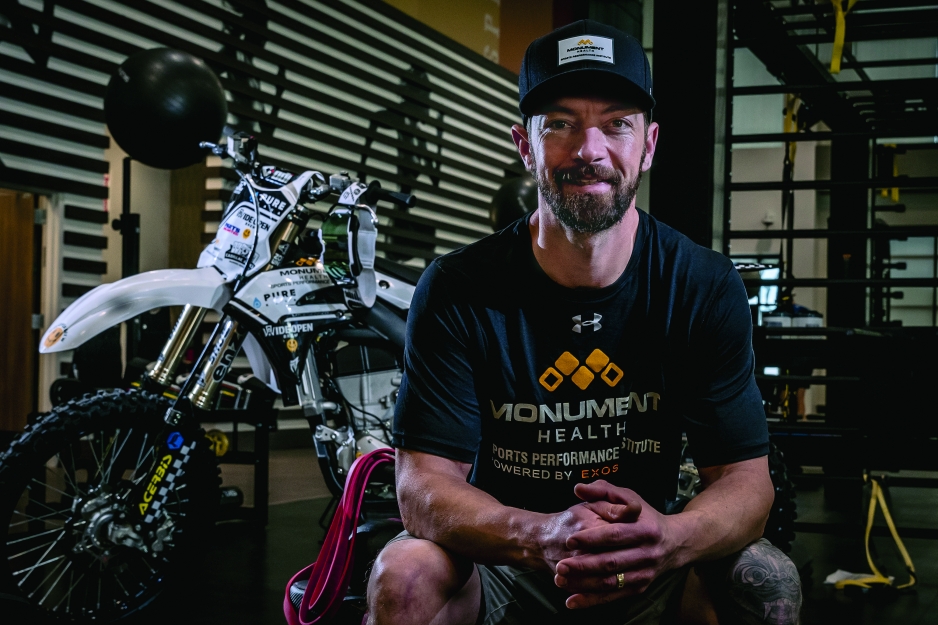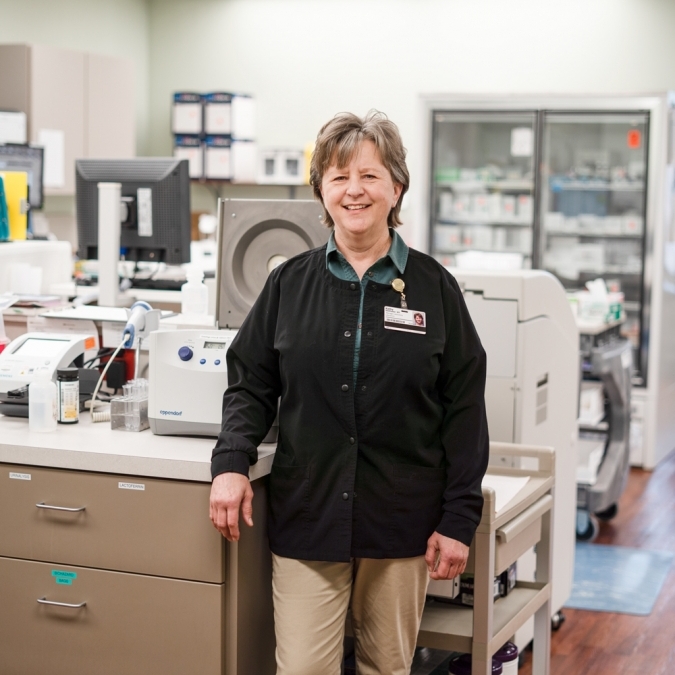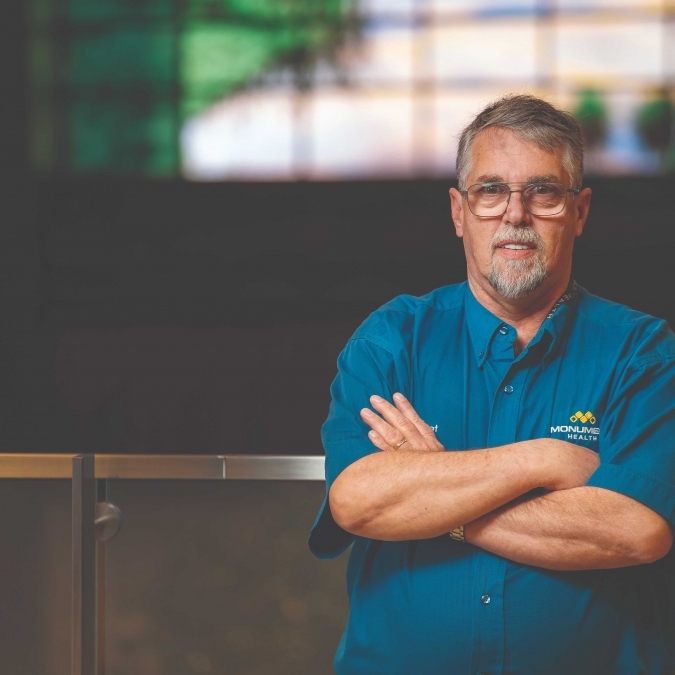Growing up, a lot of young people have posters on their walls of athletes and individuals they idolize. They dream of competing with them some day, and in that way, James Carter is living the dream. In the past decade, he’s competed in the same motocross competitions alongside athletes that had previously adorned his childhood walls.
“I’ve been doing freestyle motocross since 2008, and if you’re not super familiar with the sport, it’s basically any type of trick on a dirt bike,” James explained cheerfully. “So that’s anything from backflips to hanging off the bike at 35 feet in the air across a 75-foot gap.” The smile on his face makes it obvious that he loves what he does.
In 2020, James signed a sports performance agreement with Monument Health Sports Performance Institute. He said, “My partnership with Monument Health is one of the biggest accomplishments I have had in my career. I knew I could expect the best health care and great physical therapy — everything I could ask for to know my health would be at 100 percent, which is key for a successful athlete.”
Having ridden, and placed first, in competitions around the globe, and securing sponsorship doing what he loves, it wouldn’t be a stretch to say that James is living the dream.
But living the dream isn’t easy — it takes a lot of hard work and sacrifice to become a professional freestyle motocross legend, and sometimes the best of dreams have moments out of nightmares. That’s something James understands all too well.
James Carter is a professional freestyle motocross athlete who has performed in shows and contests around the globe. This includes the X Games, Nitro Circus World Games, Masters of Dirt and Red Bull X Fighters. As a Monument Health sponsored athlete, James has access to all the training areas at Monument Health Sports Performance Institute powered by exos, and the specialists that work there.
“You know, I wasn’t planning on a sponsorship for me as a rider — I reached out to Monument Health because I was looking for sponsors for the DeadwoodMoto show. I connected with the right people, and I was grateful that Monument Health did sponsor the event. Right after, we had a meeting, and one of the things we talked about was sponsoring me as an athlete, which has been a relationship that I’m really grateful for,” said James.
“If you’re wanting to meet and exceed your goals as an athlete, this place and these people will help you do it.”

The crash
“The last year has probably been one of the wildest times in my life,” James said. “I went from being 32 years old, feeling the best I’ve ever felt and performing the best I ever have, to all of a sudden having an accident — something that seemed, at first, so small compared to everything I’ve done — that turned out to be pretty devastating,” he explained.
James was in Massachusetts when he had the accident, riding a full course at his friend’s property. He took a run at a newly built jump, but it didn’t go as planned. “I over-jumped the first jump, which put me in the face of the next jump,” he said. “I hit my face on the handlebars, and you tend to lose all control after that. You get pushed toward the back of the seat, and it’s a little hard to explain, but your wrist moves down and gives you a bit of a wispy throttle on the next jump.”
Unfortunately for James, the next jump was even more aggressive. He was thrown 30 feet in the air across an 80-foot gap, flying off the bike at its apex, then landing on the backside knuckle — the spot where the landing area meets the downward slope of the ground — on his elbows and knees.
James immediately, and correctly, suspected that he had broken his left femur — he had broken his right femur in 2012 and this felt similar to him. What he first believed to be a dislocated shoulder turned out to be a fractured humerus on his right side. “I knew right away that something bad was going on. We called an ambulance and went straight to the emergency room.”
Hospitalization
To fully recover from his injuries and get back on the bike, James would need to commit to physical therapy. As a Monument Health-sponsored athlete, he knew that excellent physical therapists were ready to help at Monument Health Sports Performance Institute powered by exos, but there was just one problem: James was trapped in a hospital in Massachusetts as the COVID-19 pandemic began wreaking havoc on health care across the country.
Things went from bad to worse. James developed a deep vein thrombosis, a blood clot that often occurs in patients with broken femurs, and then contracted COVID-19 while in the hospital. Despite his condition, he struggled to get any information from his physicians and care team.
“I just didn’t feel like the health care workers there were on my side, and I never had a doctor ever come in and tell me what was going on,” he said with a sigh. “Of course, I was concerned about my future, from the perspective of my health as well as my career. All I really wanted to do was get home, because I knew I’d be in better hands at Monument Health.”
Travel restrictions made that difficult, and even after he had recovered from COVID-19, his blood clot meant James couldn’t fly. The solution to that problem was to rent an RV and drive from Boston to Rapid City. “Luckily I had my buddy Zac Meier, who is also my photographer, who had come out with me to get footage, and he stuck around. My dad also flew out, and the two of them took turns driving straight through.”
“I tried to lay in the back of the RV, and riding in those things is not soft at all,” James continued. “I bounced around and then finally had to move to the front on the couch and just lay there the whole time. It wasn’t an easy trip, but I was so grateful to be home with my daughter, wife, my friends and doctors I knew I could count on.”
Rounding the corner
Returning to South Dakota was a turning point for James. Reunited with family and friends, he began feeling more secure in his future. “Once we got back here, got situated and I talked to Dr. (Daniel) Lochmann, I started to feel a whole lot better about everything,” James said. “He made me feel so much more confident about the prospect of coming back and riding again, although I’ll admit that I definitely thought it wouldn’t take as long as it did.”
Even before his fractures healed, physical therapists at Monument Health got him started on the road to recovery. “When I first saw James, he was still pretty fresh off the accident. He was still using a crutch and had the sling on his right arm,” said Codi Grable, PT. “We started by focusing on basic range of motion, pain control, getting some of his muscles firing again and just getting back to normal day-to-day function and mobility.”
As James made progress, Codi began focusing on higher level strength and getting James into some one-on-one training at Sports Performance Institute. She said it seemed easier to get started with strength in the lower extremities, and then move on to higher-level plyometric exercises with his upper body.
“It was important that we train him to be able to handle the impact of the bike landing, to be able to retain control and not have his hands fall off the bars or anything like that,” Codi said. To help with this, Codi had James do blood flow restriction training, or BFR, which essentially uses a dynamic blood pressure cuff to reduce blood flow to an area. “This tricks your muscles into thinking they’re doing more work than they are,” Codi said. “It allowed us to rebuild some of James’ muscle mass without over-stressing the fracture sites.”
Bryan Olson, PT, also used dry needling to help relieve some pain and tenderness in the injured extremities. Dry needling is a treatment in which a thin needle is pushed through the skin into underlying trigger points in muscle tissue. It may sound a little painful, but is usually only mildly uncomfortable and can relieve a lot of muscle tension and pain.
When Codi went on leave, Bryan also stepped in to help James take the next steps in his rehabilitation. “I got to come in and start working on high-level activities with James, building greater strength in the shoulder and leg and trying to challenge him more in a plyometric capacity, just trying to get him ready for the demands he would face freestyling on the bike.”
Into the gym and beyond
As physical therapy progressed, James was ready to start working with Performance Coach Chris Hathaway at Monument Health Sports Performance Institute powered by exos. “My training with Chris focused on really getting me even stronger than I was before, not just being okay,” James said. “The whole idea was how to make me better on the bike, and I’ll admit that there were days that I hated it. Of course, by the end of the week I would feel better, then the following week, Chris would change it up and I’d be at it again.”
Chris enjoyed working with James because he brought his drive to every session. “There are days he didn’t want to be there — which happens to everyone who trains,” Chris said. “Everybody has days where they would rather stay in bed, but James never let anything stop him. I think he’s been successful at rehabilitation and training for the same reason he has been successful on the back of the dirt bike. He’s got an unstoppable positive attitude.”
Back on the bike — and beyond
After six months of physical therapy and training, it was time for the ultimate test: getting back on the bike. “Throughout my training and rehabilitation, I had one thing in mind, which was, ‘No matter what, I’m riding the September DeadwoodMoto show,’” James said.
He felt ready, but when it came time to practice, he found himself taking a lot of runs toward the ramp, but not taking the jump. “I took about 30 runs before I finally made the jump, and of course afterward I was smacking myself in the head for overthinking and stressing about it,” James said with a quiet chuckle. “Even so, I could tell my shoulder wasn’t as strong as it should be, and I knew I needed to take it easy.”
James rode during that show, and though he wanted to push himself, he exercised caution and protected his shoulder. He did the same at a show the following weekend in Rapid City. He said, “I felt even better at that show, but still I felt like my shoulder wasn’t where it needed to be, and felt like if I had grabbed with just my right arm it might have dislocated.”
Returning to physical therapy the following week, Bryan began working on new ways to focus on that rotator cuff to build more strength into the shoulder. “I’m feeling good again, and I’m still fired up about riding. Now I just want to make sure that I’m doing the right shows.”
For James, the right shows are here in South Dakota, or close enough that he doesn’t have to spend much time away from his family. “My priorities have changed a bit, and the accident is only part of that,” he explained. “I can’t see a future where I’m not riding, but from now on I want to focus on being near my family and doing fun stuff on the bike locally.”
Although James plans on staying on his bike as long as possible, he does plan for when his professional riding days are over. That’s one of the reasons that he’s turned into an entrepreneur, opening B21 Storage in 2022. He has also partnered with his friend Zac to start Wide Open Brew Coffee Co. Their coffee is available online, and they now have an enclosed trailer that converts to a merchandise stand that will sell coffee at races and events in the future.
Additionally, he’s working on ways to help kids who are getting into motocross or other motorsports, through collaborations and potential sponsorships. “I think getting kids on two wheels can make a world of a difference in their lives, just like it did in mine.”
“I don’t know exactly what will come next for me,” James said, smiling playfully. “But I’m addicted to cars, motorcycles and coffee, so you can bet they’ll be involved.”
Functional Dry Needling (FDN) is a technique used to treat dysfunction in neural, muscular or connective tissue, by inserting an extremely thin but solid needle into muscular trigger points. Dry Needling can be used to treat acute injury, chronic disease process, overuse syndromes/injuries, post-surgical diagnoses and more. Therapists at Monument Health use FDN as one part of a comprehensive approach to help improve, restore and optimize movement and function.
Dry Needling can result in:
• Increased blood flow
• Decreased pain and inflammation
• Deactivation of the trigger point
• Normalization of muscle tone

James said he felt like he was in good hands with both Codi and Bryan, because they’re both familiar with the demands of motocross. Bryan’s nephew races motocross, so he had an idea of what James would need. “There’s a lot of demands on the body when you’re doing that kind of riding,” Bryan said. “James has to control the bike and his body, while he’s riding, while in the air and then through the landing. Pain and limited mobility can really throw off that timing.”
Codi has an even better understanding of motocross. “I grew up watching motocross, and then I ended up marrying a motocross rider,” she said with a laugh. “He raced for a long time, and his family runs the 4Gmx Indoor Motocross series. Racing and freestyle are different, but if you’re familiar with one you’re familiar with the other.”
“James sustained severe long bone fractures to femur and humerus, both requiring extensive reconstruction. This was also complicated by a pulmonary embolism and COVID-19, increasing his risk of complications and need for further surgery. He had his surgery in Boston, but was able to be transferred home within a week of the accident.
He was always extremely motivated and cooperative with his rehab and recovery restrictions, needing mostly to be reminded not to be doing ‘too much.’ At one year, he is still in rehab, working to get back on his motorcycle. I wouldn’t recommend getting back on the bike too quickly, but with his ambition, it’s difficult to slow him down.”
Daniel Lochmann, M.D.
Written by Wade Ellett Photos by Bob Slocum & Zac Meier
Blood Flow Restriction (BFR) Training is a specialized treatment involving restricting circulation in an extremity while exercising at a light intensity. Despite the light intensity, exercising in this state stimulates significant responses that mimic exercising with much higher loads. This causes strength and conditioning gains, as well as supporting an accelerated healing response, that would normally require a much more intensive workout routine.
Benefits of BFR Training include:
• Accelerated soft tissue and bone healing responses.
• Applicable to patients that have limited weight-bearing ability or other limitations.
• Increased repair of muscle tissue, gains in muscular strength and improvements in overall endurance.



